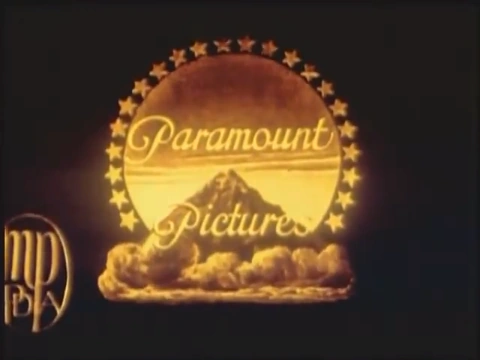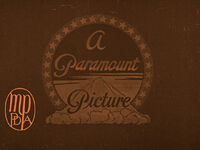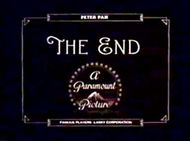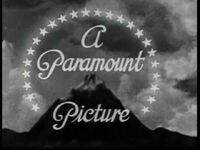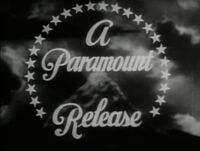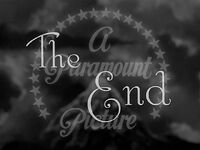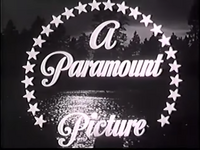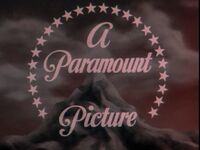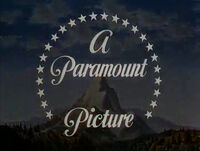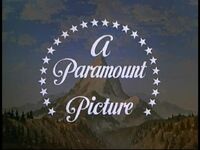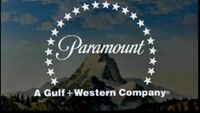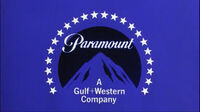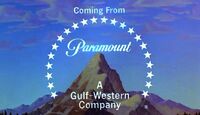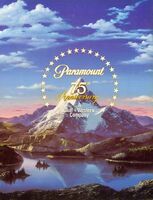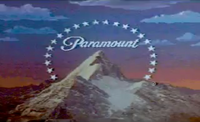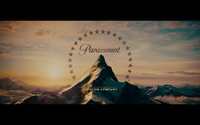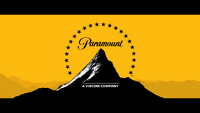| Some or all of the information on this page may have been copied from another source. Most likely, it would be Logopedia.
|
Background[]
Beginning in 1914, the former company was renamed Paramount Pictures Corporation, as the oldest running movie studio in Hollywood, beating Universal Studios by a month. On March 24, 1966, Paramount was acquired by Gulf+Western Industries, which later became Paramount Communications on June 5, 1989. On March 11, 1994, Paramount Communications was merged with Viacom. Viacom on December 31, 2005, split into two companies: one retaining its original name (that owns the BET Networks, MTV Networks and Paramount Pictures) and the other what was once the old Viacom but currently known as the "CBS Corporation" (which owns Paramount's television production and distribution arms, currently known as CBS Television Studios, CBS Television Distribution, and CBS Studios International, respectively); both companies are owned by National Amusements, Inc.
1st Logo (February 12, 1914-January 4, 1917)[]
Nicknames: "The Original Paramountain" "1910s Mountain"
Visuals: On a black background, we see a mountain above a few clouds surrrounded by stars. There is text over the mountain reading:
Paramount
Pictures
Varinat: Depending on the film, the colors are different.
Technique: None.
Audio: None or the film's opening music.
Availability: Ultra rare.
Legacy: This marks the first use of the studio's famous mountain, though it may look strange to those familiar with the later designs.
2nd Logo (January 7, 1917-August 16, 1926)[]
Nicknames: "The Three Mountains in the Credits", "Three Paramountains", "1920s Mountain"
Visuals: We see one of the following bylines at the top of the screen:
- "ADOLPH ZUKOR PRESENTS" (films produced on the East Coast).
- "JESSE L. LASKY PRESENTS" (films produced on the West Coast).
- "ADOLPH ZUKOR AND JESSE L. LASKY PRESENT" (films produced on both coasts).
Below this, we see the title of the film and a little more info. Somewhere on the screen, we see a snow capped mountain poking out of a cloud at the bottom. The mountain is surrounded by a ring of stars. We see the text overlapping the mountain reading "A Paramount Picture".
At the bottom of the screen is a box. On either side of the box, there are two Paramount pseudo-logos. Each has a ring of stars inside a ring. On the pseudo-logo on the right, we see the words "Paramount Pictures". On the pseudo-logo on the left, we see some writing. At the top of the box, we see "COPYRIGHT [YEAR]". Inside the box, we see the words "FAMOUS PLAYERS-LASKY CORPORATION" in a large font. Below this, in a slightly smaller font, we see the words "ADOLPH ZUKOR, PRESIDENT". Below Zukor's name, we see the words "NEW YORK CITY". Below the box, we see, in a large font, "ALL RIGHTS RESERVED".
Closing Title: We see the words "THE END" on the screen. At the top of the screen is the title of the movie. Below "THE END", we see the opening logo.
Closing Variants: On some films like the above described, the "A Paramount Picture" logo appears after the movie ends. After a few seconds, the "THE END" overlaps the logo and fades out. Another variant, from Stage Struck (1925), shows the "THE END" in white script with the "T" and E" in fancy lettering. After a few seconds, the "A Paramount Picture" pseudo-logo is seen on a reddish pink background.
Technique: None. It was actually a painting that was filmed by a cameraman.
Audio: None.
Availability: Ultra rare.
Legacy: This is the first ever use of the famous mountain, though its design is strange to those familiar to the later designs.
3rd Logo (August 25, 1926-November 28, 1953)[]
Nicknames: "Majestic Mountain", "Dark Mountain", "Paramountain", "1930s Mountain"
Visuals: We see a snow-capped mountain against a dark sky. There are clouds that look like smoke over the mountain; sometimes foggy, though. Encircling the mountain are 24 white stars, accompanied by this text in a majestic script font overlapping the mountain, reading "A Paramount Picture".
Closing Title: We see "The End", in script, overlapping the company name. On many movies, "The End" fades out, leaving only the logo and "A Paramount Picture".
Variants:
- On some of Paramount's earlier movies, the pseudo-logo "A Paramount Picture" is nowhere to be seen in the movie's title, keeping only the two small pseudo-logos below the title. Instead, the full "A Paramount Picture" logo is seen after it. After a few seconds, the movie's credits overlap the logo. It can be seen on movies like Love 'Em or Leave 'Em (1926).
- Though the same general design of the logo has remained the same, there have been subtle changes to it over the years, such as having brighter stars on some films or a slightly different design. Sometimes, "A" and "Picture" fade out a little bit and "PRESENTS" fades in below "Paramount".
- On the infamous Koch Media widescreen DVD and Blu-ray of the animated 1939 Gulliver's Travels, the opening Paramount logo is still on a (poorly) retouched widescreen background, then the "filmed" portion of the mountain stretches and morphs as its fades into the opening title card. The closing variant is similar to the opening version as well, morphing and all.
Trivia: Legend says the mountain was doodled by W. W. Hodkinson during a meeting with Adolph Zukor. Hodkinson said it reminded him of his childhood in Utah.
Technique: Gliding effects.
Audio: The beginning/end of a movie's theme. Starting with the 1930 feature Paramount on Parade, almost all of the Paramount feature films used the fanfare "Paramount on Parade" (written by Elsie Janis and Jack King).
Availability: Still retained on films of the era. On old prints of the Paramount films distributed by MCA TV, they are usually plastered with the MCA-TV logo of the time, while on current prints Universal owns from the MCA package, the 1997 Universal logo precedes it. The last films to use this logo was Forever Female. The logo made a surprise appearance at the beginning of Broadway Bill (originally a Columbia Pictures release by Frank Capra; Paramount acquired the rights years after they remade the film as Riding High).
4th Logo (October 12, 1934-February 1, 1952)[]
Nickname: "The Popular Science Mountain", "Mount Everest", "1940s Mountain"
Visuals:
- 1934-1936 Variant: We see a mountain shooting above a cloud deck below. A ring of 19 or 24 stars, similar to the one seen on the Paramount blue mountain logo are seen. In an unusual font, we see the words "A Paramount Picture".
- 1936-1949 Variant: We see a brown mountain with a brownish sky. This logo is similar to the Paramount movie logo, except the word "Paramount" is slightly below the top of the mountain. This logo contained 30 stars.
- 1941-1945 Variant: We see a brown mountain with a sky in a brighter general shade of color above a pinkish orange cloud deck below.
- 1944-1952 Variant: We see a brownish or bluish mountain (similar to the one from the 5th logo) with a greenish blue sky and gray clouds.
Openings:
- Popular Science (1934-1949): We see a cartoon airplane zooming toward us. After the plane passes, we see either "ADOLPH ZUKOR PRESENTS" or "PARAMOUNT PRESENTS" while we're looking down at the airplane. The words "POPULAR SCIENCE" are seen on the airplane's wings. At the bottom there is a copyright, and a Paramount pseudo-logo. Also present may be another copyright notice for Shields Pictures. This is followed by the credits.
- Unusual Occupations (1936-1949): On a shining red background, we see the above words, except the words "UNUSUAL OCCUPATIONS" are seen.
Technique: None.
Audio: Usually the opening music/audio of any given film. Sometimes, it is silent, or on a rare occasion it would use the Paramount on Parade theme.
Audio Variants:
- Popular Science: A variation of the Paramount on Parade fanfare accompanies the sound of the airplane passing.
- Unusual Occupations: A patriotic theme is heard, which leads into a medley of "I've Been Working on the Railroad", "Pop Goes the Weasel" and "Old MacDonald Had a Farm".
Availability: Uncommon. It's still seen on Paramount color releases of the period, and on the aforementioned shorts that have had barely any exposure since AMC stopped playing them more than a decade ago (where they aired under the umbrella title AMC Short Cuts).
5th Logo (December 23, 1950-October 22, 1953)[]
Nicknames: "Majestic Mountain II", "Twisted Mountain", "Ugly Mountain", "Paramountain II", "Lopsided Mountain", "Early Blue Mountain", "1950s Mountain"
Visuals: The same as the 4th logo, only this variation looks more marble and uneven in appearance. The sky background is a bit lighter as well.
Variant: On films released prior to the widescreen feature Shane, the logo is closer up.
Technique: Gliding effects.
Audio: Usually the opening music/audio of any given film. Sometimes, it is silent, or on a rare occasion it would use the Paramount on Parade theme.
Availability: Uncommon. Like the previous logo, it can still seen on Paramount color releases of the period, including Branded, When Worlds Collide!, The Greatest Show on Earth, Shane, Arrowhead, and The War of the Worlds, among others. The last film to use this logo was Here Comes the Girls. Also, it makes a surprise appearance at the beginning of the Duckman episode "The Road to Dendron".
Legacy: The more lopsided mountain makes it an eyesore, especially with the stars now being disconnected.
6th Logo (May 27, 1953-September 25, 1975)[]
Nicknames: "Majestic Mountain III", "VistaVision Mountain", "Perumount", "Gulf+Western Mountain", "60s/70s Mountain"
Visuals: Originally created for Paramount's 3-D process called "Paravision" and later modified especially for widescreen, this logo appears more realistic and features a canyon scenery with trees around it. The sky is more distant in depth and is very contrast. Everything is pretty much the same as before here.
Trivia:
- The mountain that you see is known as "Artesonraju", a mountain in Peru.
- The painting of the mountain was created by matte artist Jan Domela.
Variants: Several renditions of this logo have been discovered. This is going to get complicated, so let's explain this simply. There are many main variations of this logo:
- May 27, 1953-October 8, 1968: "A Paramount Picture" or "A Paramount Release" (written in the Paramount corporate font). When this logo--where the text and stars were bigger and the mountain was seen from afar--debuted on Paramount's first 3-D picture, Sangaree, the words "A Paramount Picture" faded a few seconds later to the words "in 3 Dimension". At the end of the movie, the "The End" byline appears by itself, right in front of the mountain. It then fades to the company name a few moments later. The standard opening version was later seen on Those Redheads from Seattle and Money from Home.
- October 10, 1968-September 25, 1975: "Paramount" (in the same font) is seen on the mountain's peak, with the stars encircling the mountain. The byline "A Gulf+Western Company" appears on the bottom. Sometimes, the font for "Paramount" is different.
- On films with VistaVision, the stars and text would fade out, and "in" would fade in. Then it fades out and a big "V" zooming in (a la the Viacom "V of Doom" logo) and "VISTA" left of the V and "ISION" right of the "V" appear in a wiping effect. Then, "MOTION PICTURE" appears under "VISTA" and "HIGH-FIDELITY" under "ISION" fade in.
- On White Christmas, "Paramount (with the "P" written in their corporate font) proudly presents the first picture in" would first appear over the mountain, and then the VistaVision logo appeared, without any "MOTION PICTURE" or "HIGH FIDELITY" texts, then the Paramount logo played as usual.
- The logo has appeared in Spanish ("Paramount Films Presenta"), French ("C'est un film Paramount", or "Distribué par Paramount"), and German ("Ein Paramount Film").
- Another version exists at the beginning of movie trailers, where we see the 24 stars, and then "COMING FROM Paramount Pictures" (or "COMING FROM Paramount" since 1968) appears one by one in the center, with the Gulf+Western byline appearing below in the latter variation. It was used until around 1977. However, trailers for Harold and Maude had the normal version of this logo instead, and the one for Serpico features no logo.
- A black and white version is used on the trailer for Paper Moon.
- This logo was changed in 1974. Here, two of the stars are clipped away. The mountain looks the same as logo 2's version, but the stars are bigger. "A Gulf+" slides in from the left and "+Western Company" from the right in Helvetica Black typeface. The script name also had a few variations of its own. At least three movies, The Great Gatsby, Brother Sun, Sister Moon and Death Wish, featured the then-current TV logo version, and the standard 1974 logo features the print logo variation, which remains from this day forward.
- A variation that exists has the logo as usual, but this time the mountain is simply a drawing with one color: Orange-brown. Seen on War and Peace (1956).
- Some movies, such as Lady Sings the Blues (1972) and The Italian Job (1969) as well as the end of Rosemary's Baby (1968), had a still version of this logo. However, The Criterion Collection prints of The Italian Job (1969) has the normal version instead.
- Sometimes, the text and stars appear in shadow mode. This can be found on True Grit (1969) and the 2002 DVD version of Big Jake (a Cinema Center Films production strangely; seen before the logo of the former company).
- On some movies, like Alfie (1966), the clouds move a bit faster than in the normal version.
- Is Paris Burning? has a different drawing of the mountain in the ending. Also, the stars are kept intact and instead of "A Paramount Picture", we see "THE END", in white, overlapping the mountain.
- On Barbarella, the Gulf + Western byline is slightly off-center.
Technique: Gliding effects, combined with cel animation, done by Famous Studios for the VistaVision variant.
Audio: Most of the time, it is silent or has the beginning/end music from any given film. For films shown in VistaVision, the logo has a majestic fanfare composed by Nathan Van Cleave, except on those like Gunfight at the O.K. Corral, Strategic Air Command, and Vertigo, which had the opening themes. Some TV movies, such as Seven in Darkness, had an extended version of the 1969 Paramount Television "Closet Killer" theme from the era. On Money from Home, it had a different brass fanfare, composed by Leigh Harline.
Audio Variants:
- The VistaVision fanfare was sometimes rearranged specially for films such as The Desperate Hours (Gail Kubik, Daniele Amfitheatrof), The Tin Star (Elmer Bernstein), and Artists and Models (Walter Scharf; this version is also low-toned).
- For the "COMING FROM" variant, a rhythmic timpani sound is heard for each word that appears, followed by a drum beat.
- On Charlotte's Web, a 13-note orchestra fanfare that utilized part of the opening song "Deep in the Dark" is heard.
Availability: Common. Again, preserved on most Paramount releases of the period.
- This logo, without the VistaVision logo, was first seen on Sangaree.
- The VistaVision version is mostly seen on Western films (including Last Train from Gun Hill,; preserved in its entirety on the Magnetic Video and Starmaker Video VHS releases), but also appears on White Christmas (the first film to use the VistaVision variation) and Vertigo.
- It was plastered by the 1963 Universal logo at the beginning of four Hitchcock films that Paramount merely released: The Trouble with Harry, The Man Who Knew Too Much, Vertigo, and Rear Window; more recent prints of the films restore the logos. Another Hitchcock production from Paramount, Psycho, also preserves this logo on its initial MCA Videocassette, Inc. release, as well as all releases from 1989 onward. It is unknown whether this and/or the Universal logo appears on the DiscoVision release.
- This logo surprisingly appeared at the beginning of the Indiana Jones films (but with the Gulf+Western byline as seen in the 6th logo added in) and Big Top Pee-wee. It was most recently seen at the start of the IMAX version of Raiders of the Lost Ark.
- Among the titles released with the 1968-74 variation were The Godfather, Catch-22, On a Clear Day You Can See Forever, Charlotte's Web, Paint Your Wagon, Harold and Maude, Willy Wonka & the Chocolate Factory (which is now owned by Warner Bros. Pictures, so you'll have to find it on original prints, which are extremely hard to find), Rosemary's Baby, and The Parallax View. Also seen at the end of Chinatown, which had the 2nd logo at the beginning, and at the end of the 2001 DVD release of The Godfather Part II.
- The 1974-75 variation can be found on The Longest Yard (1974), The Godfather Part II, The Day of the Locust, Bug, Nashville, Framed, and Three Days of the Condor, and also plasters the 1968-74 variation on many current prints of Goodbye, Columbus and the 1953 variation on the 1982 VHS of The Sons of Katie Elder.
- New prints of Danger: Diabolik and Such Good Friends, the 1995 VHS of Charlotte's Web, and earlier DVD releases of the first two Godfather films have this logo plastered with the 1986 logo, while many current prints of Once Upon a Time in the West, Barbarella, Ace High, Downhill Racer, Fear is the Key, Three Days of the Condor, and Murphy's War, as well as a 1988 Canadian VHS of Plaza Suite, have this logo plastered with the 6th logo (although this logo is kept at the end of Barbarella and at the start of a HDNet Movies airing of Condor).
- The last film to use this logo was Three Days of the Condor.
Legacy: This is one of the more famous mountains made for Paramount, and a favorite among fans of their older films.
7th Logo (October 8, 1975-December 12, 1986)[]
Nicknames: "Blue Mountain", "Abstract Mountain", "'1980s Mountain", "Fading Mountain", "VistaVision Mountain II", "Perumount II", "Gulf+Western Mountain II"
Visuals: We see the same mountain with the canyon-style scenery as the previous logo. 22 white stars fade in, encircling the mountain. The word "Paramount" fades in on the mountain's peak. "A Gulf+Western Company" fades in at the base of the mountain. The logo then fades to a light blue mountain surrounded by a circular navy blue border on a light blue screen. The final product turns out to be Paramount's current print logo from that point onward, but as most print logos, they change over the years, because in the future, the byline for this logo will change two times. This logo is similar to the Paramount Television ID of the period, but has darker colors compared to the TV ID.
Variants:
- The distance between the words and the mountain tip sometimes varies.
- The size of the logo may vary.
- One variation (probably the original) has a smaller blue circle around a smaller mountain, both kind of receded. The text for "Paramount" is smaller than usual and the text for "A Gulf+Western Company" is drastically larger, along with the stars. This rather ugly variation was seen on Hustle, Leadbelly, The Last Tycoon and Looking for Mr. Goodbar, among others. An improved version with resized text (but still keeping the receded circle and mountain) appears on some films. This version also lacks a registered trademark (®) symbol.
- A variation of this logo was used as a bumper for trailers to upcoming films with the phrase "Coming From" above the logo. However, trailers for Popeye and D.A.R.Y.L., among some other movies, had the normal version instead, and the trailers for Atlantic City and Beverly Hills Cop leave the logo off entirely.
- On the trailer for Witness, this version is used, but is already formed.
- On the trailer for "Crocodile" Dundee, the bumper starts just before it fades to the print logo, which then fades to a mound of dirt.
- A freeze-framed, videotaped version appears at the front of three TV spots for Witness, all of which (along with the aforementioned trailer) can be seen on its 2005 DVD release.
Technique: A mix of gliding effects and fading effects, done by Hanna-Barbera.
Audio: Often had no music, or the film's opening/closing theme. In some cases, a new orchestral fanfare by Lalo Schifrin, based loosely on "Paramount on Parade," was used on the "Coming From" variant of the logo on trailers for films like Islands in the Stream, Saturday Night Fever, Foul Play, Race For Your Life, Charlie Brown, and Airplane!. (On the trailers for The Dead Zone, Witness, and "Crocodile" Dundee, the trailer's opening theme is instead heard, and on the trailers for Heaven Can Wait, Ordinary People, Gallipoli, and 48 Hrs., there is no music.) A few films, such as Starting Over, had this fanfare at the beginning.
Audio Variants:
- On Won Ton Ton: The Dog Who Saved Hollywood, the fanfare is an actual arrangement of "Paramount on Parade."
- Older prints of Grease had a theme, which seems to be a horn re-orchestration of the intro to "Love is a Many-Splendored Thing".
- Supposedly, on the 2002 DVD of The Big Bus (and the 2013 Warner Archive reprint), it uses the 1987 re-orchestration of the theme, likely due to a sloppy reverse plastering job when the 1986 logo plastered it on its 90s VHS release.
Availability: Common. Can be found on most release versions of their mid '70s-mid '80s output. Most films released on VHS, DVD, Blu-ray, and 4K Ultra HD Blu-ray, as well as TV airings and streaming versions, have this logo intact or restored as well (however, the 1988 VHS of Marathon Man omits the logo and goes right to the opening credits).
- This logo premiered on Mahogany and was used up until Star Trek IV: The Voyage Home, the last film to have it at both ends. The Golden Child also had this logo, but only at the end (the 7th logo is at the beginning).
- It has been restored on the 2007 Sony DVD release and TV broadcasts of Meatballs, while in prior cases it was plastered with the 1986 logo.
- It also appears at the end of the first two Indiana Jones films (and the DVD version of The Last Crusade), Robert Altman's Popeye, and Hulu's print of Bug, which all had the 1953 logo at the beginning.
- The 1976 variation can be found on Lipstick, The Bad News Bears, The Tenant, Won Ton Ton: The Dog Who Saved Hollywood, the 1996 VHS of Race for Your Life, Charlie Brown!, Gallipoli (although the 2015 Region 4 DVD release and the Nine Network (Australia) broadcast of the film on April 25, 2015 [the 100th anniversary of the ANZAC landings at Gallipoli] had it removed, and replaced at the beginning of the film with a remastered per frame screen; however, the 2005 R4 DVD has it intact), US prints of Bugsy Malone, and many current prints of Looking for Mr. Goodbar.
- Some films have this plastered over with the 1986 logo in any of its three byline variations, such as the 2000 DVD of the Director's Cut of Star Trek: The Motion Picture (though a recent Australian airing of the film retained this logo), Grease starting with its 1998 video releases, King Kong (1976), and the 2007 DVD of Mahogany (all with the Viacom byline version). Early video releases and some post-2005 prints of Top Gun retain this logo, though all other copies plaster it with the following logo (although its 1987 VHS release only kept it at the very end, as it was plastered by the 7th logo ("75th Anniversary" variant) at the beginning). Late-1990s American TV broadcasts of Dragonslayer briefly plastered this logo with the Viacom byline version of the 1986 logo, but more recent broadcasts retain the original logo.
- Of the films released during their distribution pact with Lorimar, An Officer and a Gentleman still has this logo (albeit with Lorimar's logo removed), but The Postman Always Rings Twice (1981), (Escape to) Victory, Blake Edwards' S.O.B., and The Sea Wolves all have it removed (since the studio only had North American distribution rights), being replaced by the 1999 Warner Bros. logo on most current prints. Night School, however, had this and Lorimar's logo intact on a recent Movie Channel airing, and on the widescreen Laserdisc, with Warner's "Shield of Staleness" preceding it.
- The "Coming From" variant is usually preserved on trailers for films such as Flashdance, Saturday Night Fever, and Islands in the Stream on their DVD and Blu-ray releases (although Islands has no Blu-ray edition anywhere in the world). While the 2002 logo plasters this (but retains the original fanfare) on the trailer for Airplane! on iTunes and on the Blu-ray release, the DVD release retains this variation (Amazon Prime cuts it out entirely, putting the 2002 logo after the trailer).
- It was most recently seen at the end of the IMAX version of Raiders of the Lost Ark.
- This logo is seen on the 1982 Paramount Home Video/Gateway Video VHS release of the Star Trek episode "Space Seed," placed in between the 1980 "Acid Trip" warning and the actual episode (the Betamax version precedes the episode with a trailer for Star Trek II: The Wrath of Khan after the warning, instead of the logo).
- This strangely appears after the credits on the VHS of the 1993 film Jailbait (AKA: Streetwise), at least on the screener version.
Legacy: This is also another famous mountain, and the only one that is fully abstract, though the earlier variants look really awkward and ugly with their odd differences in size.
8th Logo (December 12, 1986-October 7, 2003)[]
Nicknames: "CGI Mountain", "1990s Mountain", "Model Mountain", "Majestic Mountain V", "75 Years of Paramount", "Happy 75th, Paramount", "Happy Anniversary, Paramount", "Paramount's 75th", "Mountain of Monotony", "Perumount III", "Gulf+Western Mountain III", "Paramount Communications Mountain", "Viacom Mountain"
Visuals: As the logo fades in, We see a model of a mountain, with a CGI lake in front of it and a light blue/yellow gradient sky with a yellow sunset behind it. As the sky darkens, the camera begins to zoom closer to the mountain, as 22 silver stars (also CGI) come from the bottom left and encircle the mountain, forming the familiar logo. The word "Paramount", in its familiar script logo font and redone in a shiny silver color, fades in on the peak of the mountain, along with the Registered Trademark "®" symbol. Seconds later, one of the four bylines (as seen below; depends on the year(s) seen below) fades in below the logo (not the international version).
Trivia: Paramount used a painting commissioned for its 75th Anniversary from artist Dario Campanile as a basis for this logo, which can be seen Here.
Bylines:
- December 12, 1986-August 30, 1989: "A Gulf+Western Company" (it fades in together with the Paramount script logo and looks the same as it did in the previous logo).
- September 22, 1989-December 23, 1994: "A Paramount Communications Company" with a line above the byline fades in, in white. On the byline's first year, the byline faded in with the Paramount script logo like the Gulf+Western version and was in gold. On video releases from the era with this variant, the color scheme of the logo is more washed-out than normal.
- February 17, 1995-October 7, 2003: "A VIACOM COMPANY" (in the 1990 \/|/\CO/\/\ "Wigga-Wigga" font), with a line above the byline fades in, again, in white.
- One variant, used on the trailer for Mission: Impossible II and international releases, has no byline whatsoever. (See below.)
Variants: While there have been some variations of the logo depending on the movie, and of course the three byline variants, there are two main logo variations of this logo:
- December 12, 1986-December 18, 1987: For this logo's first official year (1987, even though the logo actually debuted in 1986), the words "75th Anniversary" appear over the mountain, between the Paramount script logo and the Gulf + Western byline. "75th" was in silver with "75" bigger and "th" smaller and "Anniversary" in gold. Also, the "™" symbol was used in place of the standard "®" mark. The first movie to use this logo, The Golden Child, used a more placeholder-like 75th Anniversary logo and a thicker font for the Gulf+Western byline.
- A telecined version existed, where it starts with an almost fully static logo (only the clouds move), but a few seconds later, the animation starts normally. Also, the color scheme of the logo is the same as the Paramount Communications variant, despite carrying the Viacom byline. This variant can be seen on 1990-2001 VHS releases, such as Peanuts tapes, the Paramount Family Favorites release of Charlotte's Web and Rugrats: Dr. Tommy Pickles. A filmed version of this variant appeared on Bringing Out the Dead (1999), Mission: Impossible II (2000), Lara Croft: Tomb Raider (2001) and Crossroads (2002) (The last film to use the logo).
- On Sliver, the logo is more zoomed in than usual.
- February 5, 1988-August 30, 1989: The "75th Anniversary" disclaimer is removed, and the Gulf+Western byline is shifted slightly up.
- March 2, 1990-October 7, 2003: The logo has been slightly enhanced, and the stars have a lighter color.
- May 21, 1993-December 23, 1994: The clouds and stars are slightly darker, and the Paramount Communications byline now has a shadow.
- June 30, 1999-February 15, 2002: Paramount slightly redid their logo. The same basic concept is here, but is reanimated to look nicer. The stars are thicker (with golden sides), shinier, and have a nice motion blur effect. Their reflection can now be seen in the lake in front of the mountain, and the Paramount script logo and the Viacom byline now shine. The mountain now also turns dark. Also, the "®" symbol now fades in at the same time as the byline. These additions are subtle, but they make the logo seem much less dated. This version debuted on South Park: Bigger, Longer and Uncut, and made its final appearance on Crossroads. This variant has been rumored to have been animated by Pixar, though this remains unconfirmed.
- On some films with the 1999 variant, such as Runaway Bride, Error, Bringing Out the Dead (all 1999), Wonder Boys, Mission: Impossible II and Shaft (both 2000), and Rat Race (2001) as well as some prints of the Nickelodeon movie, Snow Day (2000), the logo starts with a still picture of the mountain before animating normally, much like its home video counterpart. It also has a bit of a brownish or bluish color scheme.
- Some films released from 1999 to 2002 that were shot in 2.39:1 have the stars, text and byline somewhat smaller than in the normal 16:9 variant in order to match the aspect ratio.
- An extremely rare videotaped version of the 1999 variant exists. In this variant, the mountain doesn't turn dark. This can be seen on some Paramount VHS trailers from 2000 to 2002, and on Paramount's "Now in Theaters" bumper from 2000 to 2008.
- On Double Jeopardy, the "®" symbol fades in with the Paramount script.
- On Runaway Bride, Wonder Boys and Error, the "®" symbol and Viacom byline fade in with the Paramount script.
- A rare, entirely CGI version of this logo existed in 1999. The camera rotates about an angle until it shows the logo and the stars. There are also sunflares and flashing effects at the beginning. The sky seems to be more realistic than the normal logo and looks a little similar to the 2002 logo. You see the text reversed at the beginning (along with the stars); it seems like "tnuomaraP" (Paramount). However, this variant lacks the byline. It was seen on a commercial for Paramount's Millennium Collection and on a trailer for Mission: Impossible II.
- There is also a videotaped version of the logo, which is seen on Paramount Home Video releases and also plasters older logos on VHS releases of various 60s-80s Paramount films.
- On CIC Video's The Paramount Movie Show segments, VHS trailers for Chinatown and A Place in the Sun, theatrical trailers for I.Q., The Brady Bunch Movie, Star Trek: Generations and Braveheart, TV spots for Milk Money and Drop Zone, the teaser trailer for The Indian in the Cupboard and the second trailer for Forrest Gump, the logo is bylineless.
- Sometimes, if you watch very closely, the animated clouds (and consequently, the logo) become still once the Viacom byline appears. This variant usually appears on VHS releases of TV shows and specials, and sometimes may plaster older logos on VHS and DVD. Examples of this are the 1999 and 2004 DVD releases of Star Trek: Generations.
- On the 2002 DVD of Rugrats: Decade in Diapers, syndicated airings of Death Wish 4: The Crackdown (before the Cannon logo), and at the ends of many Paramount films and VHS releases, the logo is still.
- A black-and-white version of the 75th Anniversary logo appears on the 1987 VHS of The Docks of New York.
Closing Variants:
- At the end of movies, the logo appears still. This version also appears on syndicated airings of Death Wish 4: The Crackdown before the Cannon logo.
- Despite replacing the 1995 variant as an opening logo, the 1999 variant is seldom used as a closing logo, with most films released from 1999 to 2002 instead using the 1995 variant at the end.
- On Mission: Impossible II, the logo fades in without the Viacom byline, which fades in after about a second.
Technique: A mixture of CGI animation and live-action, designed and composited by Jay Jacoby of Studio Productions (now Flip Your Lid Animation), who went on to produce the logos for Universal Pictures and 20th Century Fox, among others. The CGI stars are circling in by Omnibus/Abel an F1 Floony Computer and Apooge, Inc. for the mountain model, the 1999 enhanced version was animated at Pittard Sullivan.
Audio: A reworked version of the 1976 fanfare, with synthesized chimes added to the beginning.
Audio Variants:
- On Campus Man, a different fanfare, composed by James Newton Howard, plays during the logo.
- On Stepping Out, a different fanfare, composed by Peter Matz, plays during the logo.
- On The Naked Gun 33 1/3: The Final Insult, a different fanfare, composed by Ira Newborn, plays during the logo.
- On the Nickelodeon movie Harriet the Spy, we can hear (if you listen hard enough) some soft-sounded chimes sampled from Ole Golly's garden entrance.
- On another Nickelodeon movie, Snow Day, wind from a snowstorm is heard throughout the logo.
- On European TV airings of Braddock: Missing in Action II, the 2001 MGM lion roar is heard over the Viacom byline version of the logo, resulting in one of the sloppiest plastering jobs to walk the face of the earth. This is likely due to using a Paramount-owned TV print with audio from an MGM-owned master.
Availability: Very common, even though the logo has not been in use for more than 15 years now. While it has been plastered on some TV airings and video releases of Paramount films, as well as some remastered or restored prints, most of these still retain their original logos.
- It can be seen at the end of Big Top Pee-Wee and Indiana Jones and the Last Crusade, which both have the 5th logo at the beginning (though strangely enough, the DVD of Indiana Jones and the Last Crusade has the "Blue Mountain" at the end instead!).
- The first film to use this logo was The Golden Child, released on December 12, 1986, and the last film to use this logo was Crossroads, released on February 15, 2002; the last releases overall to use this logo were the VHS compilations Rugrats Mysteries and SpongeBob SquarePants: Bikini Bottom Bash, both released on January 28, 2003, and also on the VHS release of Blue's Clues: Blue's Big Band, released on February 4, 2003. Also seen on the region 4 DVD release of SpongeBob SquarePants: Nautical Nonsense and Sponge Buddies.
- The last film to use the Gulf+Western byline was Shirley Valentine, which was released on August 30, 1989.
- The Paramount Communications byline first appeared on Black Rain, which was released on September 22, 1989 and made its final appearance on Nobody's Fool, which was released on December 23, 1994.
- The Viacom version made its first appearance on The Brady Bunch Movie, which was released on February 17, 1995. Paramount has used this variation in all logo plasters and TV movies, such as those made for Showtime.
- The 75th Anniversary logo appeared on 1987 video releases of Top Gun, Ferris Bueller's Day Off, The Whoopee Boys, Crocodile Dundee, Children of a Lesser God, and Star Trek IV: The Voyage Home, and was plastered with its later variations for many years. Paramount nicely preserved this variant later on; it appears on the DVD releases of Planes, Trains and Automobiles and The Untouchables.
- The prototype version of the 75th Anniversary variation can be seen on The Golden Child, Hot Pursuit, and the trailer for Beverly Hills Cop II (which is preserved on iTunes and Amazon Prime).
- The Viacom variation plasters the Paramount Communications variant on post-1995 VHS releases and some DVD and Blu-ray releases of films that were released in the final two months of 1994, and among them was Star Trek: Generations. On its 1999 and 2004 DVD issues, the Viacom variant appears at both ends instead. On the 2009 Blu-ray and DVD re-release as part of the Star Trek: The Next Generation Motion Pictures Collection, the Paramount Communications variation is preserved.
- The Paramount Communications variant plasters the 1982 Orion Pictures logo on the Spike airings of First Blood. The Paramount Communications variant was found on 1989-1995 video releases, and also makes a surprise appearance at the end of Sleepy Hollow (U.S. release only), with the standard 1999 logo at the beginning of the film. The Paramount Communications variant makes surprise appearances on the Mexican DVD of Full Moon's Demonic Toys (released as Juguetes Demoniacos) and Echo Bridge Home Entertainment's DVD releases of Puppet Master 5. The tail end of it also makes a surprise appearance at the beginning of the rough cut of the final pre-reboot Mystery Science Theater 3000 episode, Diabolik (AKA: Danger: Diabolik), while the actual episode itself cuts it out.
- The standard Gulf+Western variant of this logo can be found on 1988-1989 video releases. The Gulf+Western variant makes a surprise appearance on the Razor Digital DVD of the original Puppet Master, which contains a rare uncut version and a 3-D version as well (but the latter version is not worth the effort).
- The Viacom variant of this logo was seen on 1995-2003 video releases, and at the end of AMC airings of Rambo: First Blood Part II and Prancer. Strangely, the 1995-2002 version with the Viacom byline was spotted after the split-screen credits whenever Barnyard aired on Nickelodeon; this was the result of Nickelodeon messing up the ending logos used and instead using the ones for Jimmy Neutron: Boy Genius, which was also an O/Paramount movie.
- Speaking of Jimmy Neutron, this logo appears on DVD and digital prints, as well as the Mexican VHS, but on its original North American VHS release, it was oddly plastered with the 90th Anniversary variant of the next logo.
- A silent version of the Viacom variant was used on Hulu prints of The Lorax (1972) and The Cat in the Hat, preceding the 1973 CBS Special Presentation logo.
Legacy: Much like some of the previous logos, the logo is among a fan-favorite in the logo community thanks to the seamless use of models and CGI, as well as the fanfare.
9th Logo (March 1, 2002-May 24, 2013)[]
Nicknames: "2000s Mountain", "Ultra Majestic Mountain", "CGI Mountain II", "Majestic Mountain VI", "90 Years of Paramount", "Happy 90th, Paramount", "Happy Anniversary, Paramount II", "Paramount's 90th", "Perumount IV", "Ultra Perumount", "Ultra Majestic Perumount", "Model Mountain II", "Mountain of Monotony II", "Space Mountain", "Decade Mountain", "Viacom Mountain II", "Mount Paramount"
Visuals: The camera pans down on a starry night sky background to see a set of blue clouds, As we fly backwards slowly with the camera, some comet-like objects come flying down. They fly down far enough to reveal themselves as the trademark Paramount stars. The stars zoom past the camera, making us find out we had been watching a reflection all along. The familiar "Paramount" script in the same font as before, but it’s now in sliver with a gold border because it’s in CGI. The script zooms out against a dark blue sky background with pink/purple clouds. 22 silver stars encircle the mountain. The script then continues to zoom out, taking its place at the peak of the mountain. The 1990 "/\ VI/\CO/\/\ CO/\/\P/\NY" byline from the previous logo then fades in below the logo.
Bylines: The logo was bylined by Viacom.
- March 1, 2002-March 26, 2010: "/\ \/|/\CO/\/\ CO/\/\PANY" in its 1990 Wigga-Wigga font.
- April 26, 2010-May 24, 2013: "A VIACOM COMPANY" in its 2006 font.
Variants:
- March 1-December 27, 2002: During its first year of use, the words "90TH ANNIVERSARY", in gold with "90" bigger and "TH" smaller and on the top right of "90" and "ANNIVERSARY" below, fade in with the Viacom byline and the line, sandwiched between the peak of the mountain. Again, "™" is used in place of "®" in this variation. And most notably, the logo's general shade of color is also much brighter in this variation. Sometimes, this variant would use the shade of color from the standard variant.
- A prototype variant of the 90th anniversary logo was used, where the "90TH ANNIVERSARY" text is bigger and shinier.
- A still version of the logo was spotted on international prints of Sleuth.
- This logo can open in two ways the logo could fade in already in the clouds (usually used for earlier variabts) or we pan down from a black background into the clouds.
- A variant is used at the end of every trailer for Paramount's movies on online movie stores. We see a still version of the Paramount logo with the words "(Now) Available from Paramount". Below it is a copyright stamp. It has also been seen zoomed in (so the copyright and the "now available" text is not seen, as on Amazon Prime's print of the 48 Hrs. trailer), on an iTunes print of the trailer for Airplane!, where the logo plasters the 1975 "COMING FROM" version (while keeping the music intact), and plastering the closing billing blocks on Amazon Prime prints of the trailers for Hardball, South Park: Bigger, Longer & Uncut, and Airplane II: The Sequel (with their closing music intact). Starting in 2012, the "Now" was removed, as seen on Amazon Prime's print of the trailer for Twisted.
- It exists in 1.33:1, 1.85:1, 2.35:1, and windowboxed versions.
- Sometimes, this variant fades in and cuts out, like on Amazon Prime's versions of the trailers for The Dead Zone, Beverly Hills Cop, and Fatal Attraction. On the Amazon Prime clip for Major League, it cuts in and out, and on the trailer for Varsity Blues, it only fades out partially before cutting out entirely.
- May 5, 2006-October 28, 2011: When distributing films from another company, the words "DISTRIBUTED BY", in white, are seen above the logo with the Viacom byline and the line. Usually seen at the end of DreamWorks films beginning in late 2006. It also oddly appears at the end of Iron Man, before the Marvel Studios logo. It also appears at the beginning of international prints of The Spy Next Door. An animated version did exist, but not on any movies.
- Late 2005-2011: The logo was slightly enhanced.
- April 26, 2010-May 24, 2013: The logo was enhanced once more with sleeker stars and shinier text, and the Viacom byline is switched to its 2006 font. There is an error in this variant.
- On The Honeymooners, after the logo finishes its animation, it gets knocked to the right by a bus.
- On full screen DVDs of Paramount movies shot in 2.39:1, the logo is incredibly zoomed in, since it is in the 4:3 ratio. On matted films, it is either zoomed in halfway, or it is in open matte.
Closing Variants:
- Only the finished product of the logo, with the only animation being the clouds moving westward in the background. It's basically the same as its pre-2006 television counterpart, but slightly extended and silent. Plus, the logo always fades in and fades out.
- The text "DISTRIBUTED BY" is updated starting in 2010.
Technique: CGI animation directed by Peter Schluter at BUF Compagnie; Believed to have been one of BUF's 75 Silicon Graphics 02 units The 2010 version was animated by PIC Collective.
Audio: Most of the time, it's silent or has the opening theme of the film.
Audio Variants:
- On Mean Girls and Hair Today, the Goldsmith fanfare is used. They were the last films that used this fanfare, in spite of commonly being cited as having the fanfare.
- On The Longest Yard (2005), a different fanfare, composed by Teddy Castellucci, is used.
- On AMC airings of Rambo III, this plasters the Carolco logo and keeps the low-pitched version
of the theme in one of the worst logo plastering jobs ever.
- On Twisted, wind is audible throughout the logo.
- On Jackass Number Two and Jackass 2.5 a loud jet sound is heard along with wind when the stars fly down, followed by whooshes when the stars pass by the screen, then a final whoosh sound when the Viacom byline fades in.
- On a French Paramount Channel airing of Assassination, the 1984 Cannon Films theme plays over the logo
- On some TV airings of films, the next logo's fanfare is used.
Availability: Very common. This logo can be seen on all Paramount films from 2002 to 2011, as well as Paramount video releases from 2002 to 2006.
- The 90th Anniversary variant was first seen on We Were Soldiers and last appeared on The Hours, before strangely reappearing on Charlotte’s Web 2: Wilbur’s Great Adventure. Sometimes, it plastered old logos on 2002 video releases as well as the Tri-Star Pictures logo on Encore airings of Rambo III.
- The standard version was first seen on How to Lose a Guy in 10 Days, and appears on all subsequent films with this logo.
- Also seen at the end of Elizabethtown, Zodiac, and Indiana Jones and the Kingdom of the Crystal Skull, which all had the 1953 logo at the beginning.
- It also appears at the end of Grease Sing-a-Long (a re-release of 1978's Grease), which has the 1986 logo at the beginning.
- On the Blue's Clues episode "Meet Joe" on VHS, the 1986 logo is shown at the beginning, while the 90th Anniversary closing variant plays at the end of the tape.
- It plastered the Weintraub Entertainment Group logo on a recent Encore airing of My Stepmother is an Alien, with the film's opening music; Weintraub previously had a deal with Worldvision Enterprises.
- It also plasters the 1982-1996 Orion Pictures logo on HBO, Comedy Central, and IFC airings of Bill and Ted's Excellent Adventure (also plasters the closing version of the logo at the end; the following Nelson Entertainment logo is kept intact at the beginning), and the 1995 MGM logo on older HBO airings of House Arrest.
- Surprisingly, the full version appears at the beginning of a few early episodes of Hogan's Heroes on Me-TV, including the pilot episode, as well as the HD remasters on Universal HD.
- Strangely, this logo does not appear at the beginning of Strange Wilderness (nor any of its trailers or TV spots), although the "Distributed by" variant makes an appearance at the end. This might be due to the movie's negative reception, in a similar situation to 20th Century Fox and Epic Movie.
- It makes a surprise appearance on Capture The Flag (only at the beginning, the ending of the film uses the "DISTRUBUTED BY" closing version of the next logo)
- Also seen at the end of 2006-2011 DreamWorks Animation films but don't expect this to appear at the beginning of them, unlike 20th Century Fox, since these were merely distributed by Paramount; however, it appears on the VCD release of Flushed Away, before the 2006-2010 DreamWorks Animation logo.
- It also appears at the end of Hotel for Dogs, but this doesn't actually appear at the beginning of it or on any of its promotional materials, due to Nickelodeon Movies distributing it outside of Paramount (distribution in general was handled by DreamWorks Pictures.)
- The last movies to use this logo officially were Young Adult and The Adventures of Tintin, although the "(Now) Available from" variant continued to be used for the next couple years on trailers. The closing version surprisingly appeared at the end of The Dictator and Hall of Justice, even though those movies used the next logo at the beginning.
- The "(Now) Available from" variant strangely doesn't appear on Amazon Prime's print of the trailer for Ghost, which instead uses the normal logo at the end.
Legacy: Much like the previous logo, except made with even better CGI.
10th Logo (December 16, 2011-)[]
Nicknames: "Mega Majestic Mountain", "2010s/2020s Mountain", "Ultra Majestic Mountain II", "CGI Mountain III", "Majestic Mountain VII", "100 Years of Paramount", "Happy 100th, Paramount", "Perumount V", "Ultra Perumount II", "Ultra Majestic Perumount II", "Master Majestic Perumount", "Centennial Mountain", Centennial Majestic Mountain", "Model Mountain III", "Mountain of Monotony III", "Century Mountain", "Sunset Mountain", "Decade Mountain II", "Mount Paramount II", "Viacom Mountain III", "ViacomCBS Mountain", "Paramount Global Mountain"
Visuals: Over a dark cloudy background, we see several stars flying towards us, a mirrored reference to the previous logo. As the third star flies towards us, we follow the star to reveal that we were looking at the reflection of a lake. We follow the stars as they skim the lake and create long straight ripples. We continue to fly forward as a total of 22 stars line up and encircle the mountain ahead. Then the word "Paramount" zooms back to take its place on the mountain, which is situated on a cloudy sunset landscape. Followed by the byline (depending on the version) fades in below.
Audio Descriptive Video Transcriptions: Flying stars skim across a lake towards a distinctive pyramid-like mountain with a snow covered peak, the stars form an arc over the mountain, Paramount, a Viacom/ViacomCBS Company
Bylines:
- December 16, 2011-November 8, 2019: "A VIACOM COMPANY" (in 2005-2019 Viacom logo font) from the previous logo.
- January 10, 2020-August 4, 2022: "A ViacomCBS Company" (in Gotham SemiBold font)
- October 29, 2021-March 24, 2022: "A ViacomCBS Company" set in ViacomCBS Raisonné.
- April 26, 2013, June 3, 2016, March 12, 2022-: Bylineless.
Variants:
- For the logo's first official year (2012, even though the logo actually debuted in 2011), "100 years" appears between the text and byline.
- Closing: Just like the last logo, sometimes "DISTRIBUTED BY" appears above the logo. This variant was first seen on Mission Impossible – Ghost Protocol. It was even seen at the end of Star Trek: Into Darkness. There is also an open matte "DISTRIBUTED BY" variant that can be seen at the end of The Paramount Vault prints of their movies.
- Sometimes, an open-matte fullscreen version of this logo is used. This can be seen on the Paramount Vault's prints of their movies.
- On YouTube advertisements from the side of a video (done after a video ad), a picture of the logo appears. This logo has no byline, and has a dark blue to black gradient on the sides.
- A version of this logo exists, where the camera angle is slightly different, lighter colored stars, a darker script, less light reflection on the mountain and less clouds.
- At the beginning of Daddy's Home 2 and a recent French print of Easy Down There! (1971) the byline fades in earlier than expected, when "Paramount" zooms back. . This can also be seen on trailers.
- There is a variant of the 100 Years logo where the Viacom byline is shifted up more. This can be seen on Cirque de Soleil: Worlds Away, Katy Perry: Part of Me and Bromeo and Juliet. It also even appears at the end of DreamWorks Animation's Madagascar 3: Europe's Most Wanted and Rise of the Guardians, the last two DreamWorks Animation films to be distributed by Paramount.
- On Iron Man 3, the logo starts at the point when the stars are circling the mountain and when "Paramount" zooms back.
Technique: CGI animation by Devastudios, animated using Terragen from Planetside Software (which they also used for the 2021 and 2023 Warner Bros. Pictures logos) and Autodesk Maya. Here is a behind-the-scenes look at the many layers of rendering that were required for the "100 Years" version of this logo.
Audio: A light bell and string piece which rises in intensity to become a majestic fanfare which ends in an orchestral piece, scored by Michael Giacchino and recorded at the Newman Scoring Stage at the Fox Studio Lot.
Audio Variants:
- On Mission: Impossible - Ghost Protocol, there is an alternate version with some slight changes, in effect making the theme sound more powerful.
- Sometimes, it's silent or has the opening theme.
- On some films, such as Zoolander 2, there are whooshes while the stars and text fly by with the fanfare.
- None for the closing variant. Sometimes the closing theme of the movie would be used instead.
- At the end of a Starz print of Hero and the Terror, a Cannon film, the Viacom "V of Steel" jingle plays over the closing variant due to a plastering error.
- On the 2022 German film Ee ist nur eine Phase, Hase (It's Just a Phase, Honey), the logo is accompanied by different sound effects, such as whooshes, water rippling when the stars skim on the lake. When the script reaches its position, a faint metallic banging sound is heard.
Availability: Current and very common.
- Seen on all Paramount films since Mission — Impossible: Ghost Protocol (trailers for the movie use the previous logo).
- Also seen as a de-facto home entertainment logo on Paramount's 4K UHD Blu-ray disc releases starting with Star Trek and Star Trek Into Darkness, and on regular Blu-rays/DVDs starting with the 2019 release of Bumblebee.
- The Viacom byline last appeared on Playing with Fire (Which was a Paramount Players movie); the ViacomCBS byline was first spotted on the trailer for Top Gun: Maverick and a spanish TV spots for Sonic the Hedgehog, and debuted a year later on Like a Boss.
- The ViacomCBS byline in the ViacomCBS Raisonné typeface was very rare and only appeared on trailers for Snake Eyes: G.I Joe Origins, Paranormal Activity: Next of Kin, Clifford The Big Red Dog, Scream, Jackass Forever and The In Between. Where the first five films using the byline in the Gotham font and the latter being the last film to use the ViacomCBS byline before it became Paramount Global.
- Strangely, this logo oddly appears at the end after the credits for Netflix prints for Unhappy Campers, even though the company was not actually involved in the film itself.
- It also strangely appeared on BBC broadcast prints of How to Train Your Dragon 2, Penguins of Madagascar and Kung Fu Panda 3, instead of the 2009-2020 20th Century Fox logo, even though the company did not actually distribute them.

